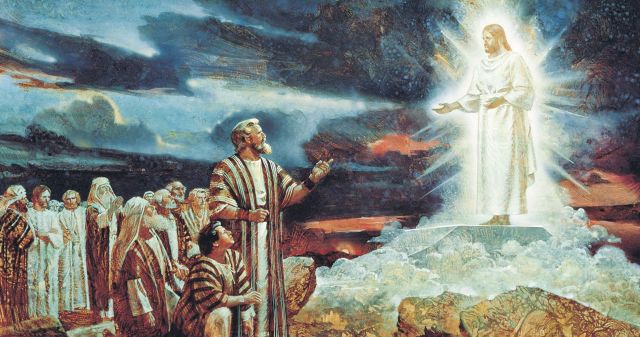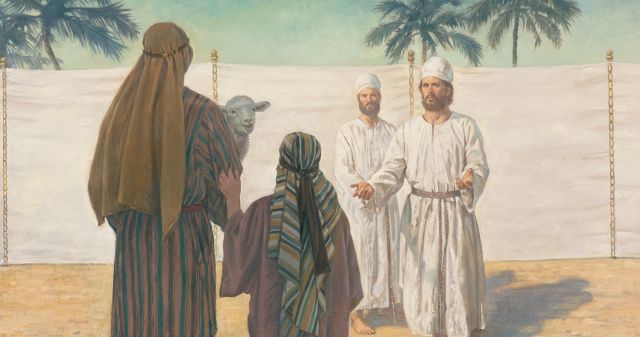Exodus, The Law of Moses, Covenants, and the Temple
by Ben Spackman
(This originally appeared on Ben Spackman’s blog)
Now that we’re getting into the desert Exodus narrative, we’re going to encounter what scholars call “legal sections” of scripture, that is, the details of the Law of Moses. I’m not interested in these so much as I am in the way the Israelites entered into the law, by covenant. So, let’s talk about these a bit more from an ancient Near Eastern perspective

The desert
Parts of a Covenant
Although there are differences, a covenant is functionally very similar to a contract or treaty. Among the ancient Israelites and their neighbors, the covenant pattern had several parts, though not every part was expressed in every covenant, nor was the order of these elements rigidly fixed. Understanding this pattern can help us understand the scriptures and the temple ordinances.
Preamble
1.The Preamble– The two parties making the covenant are identified. I’m going use buying a car as an example of a contract, a modern counterpart. The “preamble” of a contract specifies that the two parties involved are, say, Smithson Honda Dealership and John Doe.
Historical Prologue
Stipulations or Terms
Deposition of the Text
4. Deposition of the Text– The covenant/contract is written down and made known in detail to all involved parties.
Witnesses
Blessings and Cursings
All of these elements can be seen in the experience of the Israelites at Sinai (Exo. 20-24, esp. Exodus 24:5-8) and elsewhere throughout the Old Testament, and even the Book of Mormon, as in Alma 46:21-22 (discussed below). Covenants were often enacted in a covenant ceremony or ritual, most frequently involving the sacrifice of an animal. Sometimes the covenant ceremony also included a ritual meal.
Cutting a Covenant
In Hebrew, one does not “make” a covenant. Rather, one “cuts” a covenant (Heb. karat berit), perhaps because, frequently, an animal is “cut” and killed in the covenant-making process. (Joseph Smith seems to have been particularly aware of this, as JST Hebrew 9:17-18 demonstrates. This passage is not included among the JST excerpts in the LDS KJV, but it can be read here.)1 Normally, the person who brought the animal cut its throat with his right hand and collected the the blood with his left. This blood was the “blood of the covenant,” as in Exo 24:8. When instituting the sacrament, Jesus adapted the covenantal/sacrificial symbolism of the Law of Moses by calling the sacramental wine “my blood of the new covenant.” ( Matt. 26:28.)
SIMILE Curse
In effect, the sacrificed animal stood as a proxy, as a physical representation of the covenant-maker if they failed to live up to the terms of the covenant. (Well, maybe. See below). Scholars refer to physical symbolism as a “simile curse.” In Exodus 24, the “blood of the covenant” is splashed on the Israelites, as the blood would be if their throats had been cut as the animal’s throat had been cut. This is widely recognized. The sprinkling of blood on the people was a
symbolic action in which the people were identified with the sacrificed animal, so that the fate of the latter is presented as the fate to be expected by the people if they violated their sacred promise (i.e., it is a form of self-curse). Thus the ratification ceremony was, in effect, the pledging of their lives as a guarantee of obedience to the divine will.”
-Anchor Bible Dictionary, 1:1185 “Covenant.”
For a concurring analysis,
The sprinkling of blood is a ritualized oath-curse—in technical terminology, a Drohitus. The sprinkled blood of the slain animals represents the curse of death that both parties invoke upon them- selves should they prove unfaithful to their covenantal obligations. The mutual sprinkling of blood may also convey the idea that both parties now share one blood—that is, they have become kin.
– Hahn, Kinship by Covenant, 47.
The Israelites’ neighbors made these curses explicit in the written record of their treaty/covenants.
This head is not the head of the ram; it is the head of Mati’ilu. . . . Just as the ram’s head is torn off, . . . so may the head of [Mati’ilu] be torn off if he breaks the covenant.
Another example, chosen from many, comes from the city of Alalakh
Abbael swore the oath to Yarimlim and cut the neck of a lamb, [saying] ‘If I take back what I have given you [then may such happen to me.]‘
Sacrificial Patterns in the Book of Mormon
The Book of Mormon reflects this ancient pattern as well. Look at Alma 46:20-22. Moroni comes forth with the Title of Liberty, preaching.
when Moroni had proclaimed these words, behold, the people came running together with their armor girded about their loins, rending their garments in token, or as a covenant, that they would not forsake the Lord their God; or, in other words, if they should transgress the commandments of God, or fall into transgression, and be ashamed to take upon them the name of Christ, the Lord should rend them even as they had rent their garments. Now this was the covenant which they made, and they cast their garments at the feet of Moroni, saying: We covenant with our God, that we shall be destroyed, even as our brethren in the land northward, if we shall fall into transgression; yea, he may cast us at the feet of our enemies, even as we have cast our garments at thy feet to be trodden under foot, if we shall fall into transgression.
Note the connection of covenant, token, and simile curse; they tear their clothes and trample them under foot as a physical symbol. For more on simile curses in the Book of Mormon and the ancient Near Eastern background, see here.
On Pain of Death
Thus, the Israelites in Exodus 24 bound themselves to follow the Law (Heb. torah or “teaching”) of Moses on pain of death, a very solemn and serious covenant indeed. Given that the text recounts the Israelites almost immediately engaging in idolatry and other serious problems, why don’t we have tons of stories of Israelites being killed for violating the Law, as implied by the simile curses? As far as I know, we don’t have any. There are several possibilities.
- At least two human witnesses were required to put someone to death, according to Deuteronomy 17:6. The Old Testament does not record this happening with any frequency.
- It seems likely to me that these simile curses were intended to depict the seriousness of the covenant, not a literal, legal thing to be carried out by human society. Indeed, in the one case where this is carried out, it is only God who does so. (See Jeremiah 34, especially v. 18.)
- Why didn’t God, who is both a reliable witness and sees all, exercise justice and enforce his covenantal right as sovereign all the time? God is also merciful and, knowing that his children would not be perfect, provided a way to teach about the atonement and allow the Israelites time to learn and repent. Leviticus chapter 1 describes the “burnt” offering. This sacrifice required a male animal with no imperfections to be brought to the door of the Temple/Tabernacle. The person offering it placed a hand on the animal’s head, indicating that the animal was the proxy for the person; the animal was “acceptable on his behalf,” or in his place (Lev. 1:4.) Then the offerer killed the animal by cutting the throat and collecting the blood. The priests then scattered the blood and burned the animal completely upon the altar of the Temple.
In this way, the curse, the agreed-upon covenantal penalty for violating the terms of the covenant, was still carried out, but by proxy, on a male animal without blemish. Having made and ratified the covenant by sacrifice (Psa. 50:5), each sacrifice offered after that represented atonement for the person (Lev. 1:4), as well as a reminder and renewal of the original covenant.
Types of Things to Come
I should note that what I am setting forth here is not the full Law of Moses, which was a complex and diverse set of “performances and of ordinances, a law which they were to observe strictly from day to day, to keep them in remembrance of God and their duty towards him.” I have simplified the presentation somewhat to show how “these things were types of things to come” (Mosiah 13:30-31.) That is, the sacrifices of the law of Moses typified “the great and last sacrifice” (Alma 34:10-14).
Jesus and the Atonement
Though it should be obvious how this relates to Jesus and the Atonement, let me point out a few scriptures. Remember that “the reward of sin is death” (Rom. 6:23). Paul taught that Jesus “redeemed us from the curse of the law by becoming a curse for us — for it is written, ‘Cursed is everyone who hangs on a tree.’” (Gal. 3:13). The Law of Moses specified in Deuteronomy 21:22-23 that someone who committed a crime worthy of death was cursed and their body would be publicly displayed on a tree or stake. Paul draws on that passage to show that Jesus, like the burnt offering, bears the curse of the covenant for us, goes in our place, and dies in our behalf. “Surely, he hath borne our sins, and carried our sorrows.” (Isa 53:4). In doing so, Jesus, by his own blood, both fulfilled the Old Covenant and was the sacrificial animal for ratifying the New Covenant, which we make at baptism and renew each week by partaking of the sacrament. (See Jeremiah 31:31, Hebrews 9, Matthew 26:28, Moroni 4-5)
LDS Temple Covenants
So just how does all this relate to LDS Temple covenants? For starters, we don’t sacrifice animals there and there’s no blood involved. But, the ordinances and other things in the Temple are highly symbolic and referential. As with all symbols, they can mean different things depending on the context they’re in and the background of the interpreter. Some symbols may already be familiar to you, depending on your background and familiarity with symbolic systems.
The ordinances of the Temple are strongly rooted in the symbolism of the Old Testament sacrificial system, which, as shown above, represented— at least in part— covenant making and atonement. The Atonement itself is rooted in the symbolism of the Old Testament sacrifices. Sacrifice, atonement and covenant are very closely tied together in the scriptures AND in the Temple. (See the Ensign article on Atonement here.)
Teaching Moral Action Through Ritual Action
Israelites sacrificed animals in making covenants, binding them to obey the Lord’s commandments. Indeed, they were commanded to do so in specific terms by the Law of Moses. “Sacrifice” in English carries much less specific meaning than in Hebrew, where zevach literally means “ritual slaughter (of an animal.)” There is only one exception, to my knowledge. Psalm 51:17 teaches that “the sacrifices of God are a broken spirit: a broken and a contrite heart….” That should sound familiar. Once Jesus fulfilled the Law of Moses by his death, he taught the Nephites that they should “offer up unto me no more the shedding of blood; yea, your sacrifices and your burnt offerings shall be done away, for I will accept none of your sacrifices and your burnt offerings.” What were they to offer as a sacrifice? “And ye shall offer for a sacrifice unto me a broken heart and a contrite spirit.” (3 Nephi 9:19-20) In other words, the Nephites were to continue making their sacrifices of will, of humbling themselves and committing to do what God asked, just as they had done all along, but these were not to accompany animal sacrifice. Again, note the connections between atonement, sacrifice, and humbly keeping covenants in 2 Ne. 2:7 “Behold, he offereth himself a sacrifice for sin, to answer the ends of the law, unto all those who have a broken heart and a contrite spirit;”
To summarize, ritual action (sacrifice of animals, symbolic representations of curses, etc.) was associated with and designed to teach moral action (fidelity to covenants).
Postscript
One interesting thing is that simile curses like those of the Bible and ancient Near East seem pretty common. Think about kids saying “cross my heart, stick a needle in my eye.” European and American masonry involved simile curses in their ceremonies, which “serve[d] the purpose of reminding [them] of the seriousness of [their] undertakings.” I suspect it’s just human nature to put oneself on the line to emphasize fidelity and reliability. (Hey, God does it in the Bible, where he swears by himself.) On the other hand, at least with Masonry, a lot of their material was derived or adapted pretty directly from the Bible and Biblical tradition.
Further reading:
- Me, on the LDS and Israelite temples and adaptation (a very important principle!)
- I discuss Exodus 24 briefly in my article on “The Israelite Roots of Atonement Terminology” from BYU Studies.
- Mark Morisse, “Simile Curses in the Ancient Near East, Old Testament, and Book of Mormon” pdf link.
- Book of Mormon Central on simile curses.
- Roger Firestone, on Masonic penalties
More Come, Follow Me resources here.
 Ben Spackman is a PhD candidate in American Religious History at Claremont. His dissertation examines the intellectual roots of LDS creationism and evolution in the 20th century. Prior to his work at Claremont, he received a master’s degree and did PhD work in Old Testament languages and literature at the University of Chicago. He is a guest editor of a special edition of BYU Studies dedicated to biological evolution and LDS faith, and writes at BenSpackman.com.
Ben Spackman is a PhD candidate in American Religious History at Claremont. His dissertation examines the intellectual roots of LDS creationism and evolution in the 20th century. Prior to his work at Claremont, he received a master’s degree and did PhD work in Old Testament languages and literature at the University of Chicago. He is a guest editor of a special edition of BYU Studies dedicated to biological evolution and LDS faith, and writes at BenSpackman.com.

God’s ‘Glory:’ More Evidence for the Anthropomorphic Nature of God in the Bible
What Similarities Are There Between Egyptian and Israelite Temples?
Did Joseph Smith teach animal sacrifice as part of the “restoration of all things”?
Why are Old Testament penalties for disobedience so harsh?
Come, Follow Me Study and Teaching Helps — Lesson 18: Exodus 24; 31–34, Jonn Claybaugh
Audio Roundtable: Come, Follow Me Old Testament Lesson 18 (Exodus 24; 31–34)
Apr 25-May 1 (Exodus 24, 31-34) Come Follow Me Insights with Taylor and Tyler
Redeemed by the Blood of Christ (Week 18, Part 1/6) Exodus 24; 31–34 | Apr 25 – May 1, Book of Mormon Central
Priestly Initiation in Exodus 29 (Week 18, Part 2/6) Exodus 24; 31–34 | Apr 25 – May 1, Book of Mormon Central
Apr 25-May 1 (Exodus 24, 31-34) Come Follow Me Insights with Taylor and Tyler, Book of Mormon Central
The Beauty of the Sabbath Day (Week 18, Part 3/6) Exodus 24; 31–34 | Apr 25 – May 1, Book of Mormon Central
Modern False Idols (Week 18, Part 4/6) Exodus 24; 31–34 | Apr 25 – May 1, Book of Mormon Central
Parallels Between the Golden Calf and the Fall (Week 18, Part 5/6) Exodus 24; 31–34 | Apr 25 – May 1, Book of Mormon Central
- Bible Central
Book & Chapter Guide: Exodus 24, Bible Central
Book & Chapter Guide: Exodus 31, Bible Central
Book & Chapter Guide: Exodus 32, Bible Central
Book & Chapter Guide: Exodus 33, Bible Central
Book & Chapter Guide: Exodus 34, Bible Central
There was reason to be hopeful that the children of Israel would remain true to God after He revealed His law to them (see Exodus 20–23). Even though they had murmured and wavered in the past, when Moses read the law at the foot of Mount Sinai, they made this covenant: “All that the Lord hath said will we do, and be obedient” (Exodus 24:7). God then called Moses onto the mountain, telling him to build a tabernacle so “that I may dwell among them” (Exodus 25:8; see chapters 25–30).
But while Moses was at the top of the mountain learning how the Israelites could have God’s presence among them, the Israelites were at the bottom of the mountain making a golden idol to worship instead. They had just promised to “have no other gods,” yet they “turned aside quickly” from God’s commandments (Exodus 20:3; 32:8; see also Exodus 24:3). It was a surprising turn, but we know from experience that faith and commitment can sometimes be overcome by impatience, fear, or doubt. As we seek the Lord’s presence in our lives, it is encouraging to know that the Lord did not give up on ancient Israel and He will not give up on us—for He is “merciful and gracious, longsuffering, and abundant in goodness and truth” (Exodus 34:6).

Thoughts to Keep in Mind: The Tabernacle and Sacrifice
So when you find passages in the Old Testament about sacrifices and the tabernacle (or later, the temple)—and you’ll find a lot of them—remember that the primary purpose of it all is to strengthen your faith in the Messiah, Jesus Christ. Let your heart and your mind turn to Him. Ponder what He has done to bring you back into God’s presence—and what you will do to follow Him.
Thoughts to keep in mind: The Tabernacle and Sacrifice
